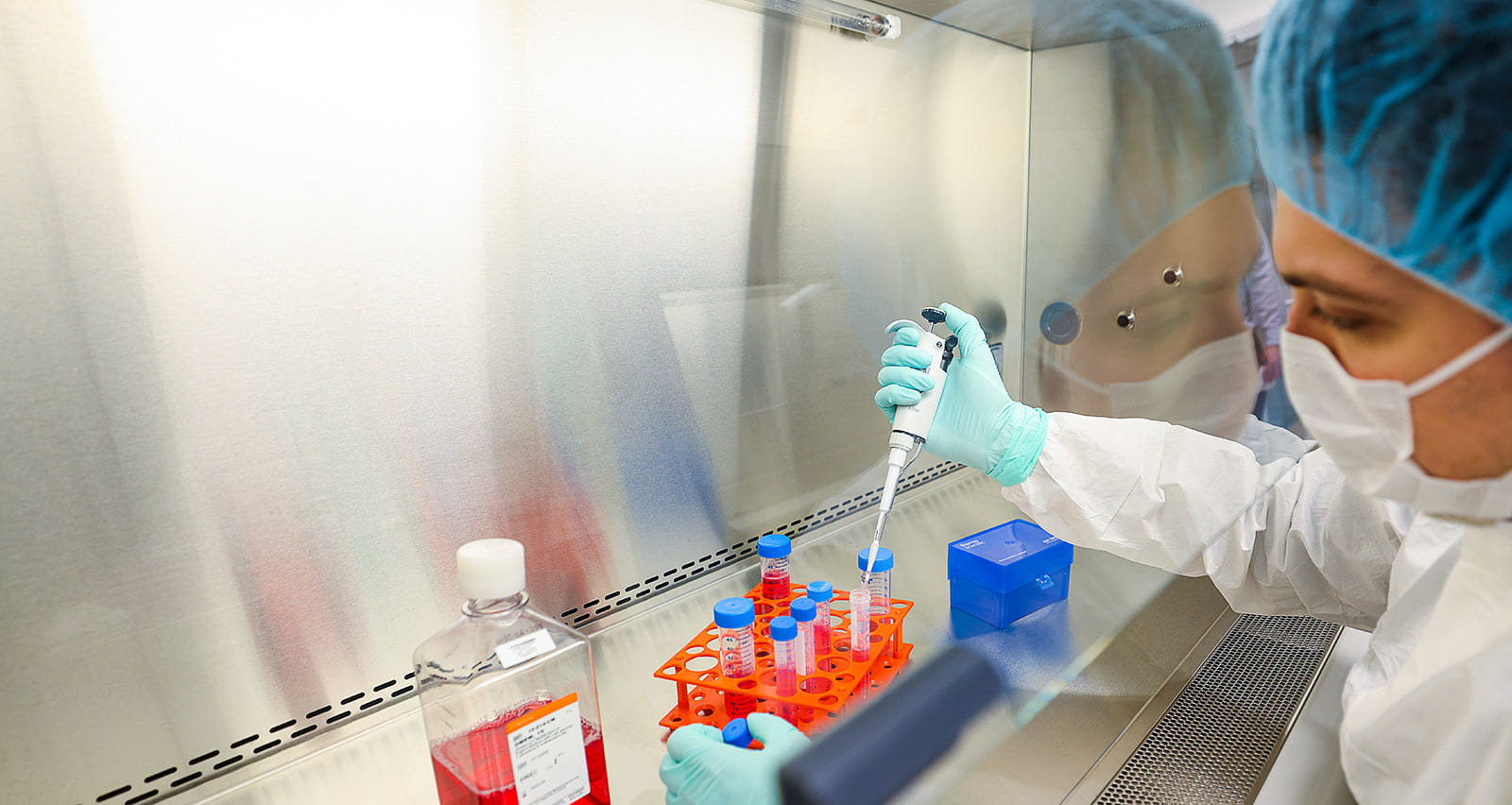
Non-Hodgkin Lymphoma
Also known as non-Hodgkin’s lymphoma or NHL, non-Hodgkin lymphoma is a group of blood cancers that form in the lymph system. Non-Hodgkin lymphoma is the seventh most common cancer in the U.S.
Through advances in diagnosis and treatment, including access to non-Hodgkin lymphoma-specific clinical trials, the lymphoma specialists at University Hospitals Seidman Cancer Center are improving and extending the lives of NHL patients every day.
Your health is important. Get expert care.
Offering in-person, video and telephone visits. Call 216-844-3951 today to see which option is right for you.
Learn more about virtual visitWhat Are Lymphocytes?
To understand lymphoma, it is helpful to know what the lymphatic system is and how it works. Lymphocytes, the cells that cause lymphoma, are present in the lymph nodes and within most organs of the body. Lymphocytes circulate throughout the body and play a very important role in defending us from infections.
Different types of lymphoma are derived from different types of lymphocytes, including B-cells, T-cells and NK-cells. B-cell lymphoma and T-cell lymphoma are the more common types, while NK-cell lymphoma is rare.
What Is Non-Hodgkin Lymphoma?
Lymphoma is a cancer that starts in lymphocytes found in the lymphatic system. There are two primary types of lymphoma:
- Non-Hodgkin lymphoma
- Hodgkin lymphoma (HL)
The primary difference between NHL and Hodgkin lymphoma has to do with the presence or absence of Reed-Sternberg cells (a certain type of large, abnormal lymphocyte that may contain more than one nucleus), when the cancer is viewed under a microscope. If Reed-Sternberg cells are present, the cancer is classified as Hodgkin lymphoma. If Reed-Sternberg cells are absent, the cancer is classified as NHL.
What Causes Non-Hodgkin Lymphoma?
All lymphomas begin when a lymphocyte develops a genetic mutation – this mutation causes the diseased cells to divide and multiply out of control. Experts do not yet fully understand what causes non-Hodgkin lymphoma and most other types of lymphoma. However, certain risk factors raise a person’s chance of developing NHL, including:
- Age: The more common types of NHL affect more people in their 60s and 70s than in other age groups.
- Gender: Men are at a slightly higher risk of developing NHL than women.
- Epstein-Barr virus (EBV) infection: EBV is the virus that causes mononucleosis (mono). People who have been infected with EBV may have a higher risk of NHL. However, many people get infected with EBV and very few of them develop NHL.
- Certain other infections: Infection from other viruses and bacteria can increase risk for some types of NHL, including infection from the hepatitis C virus, the HTLV-1 virus and Helicobacter pylori bacteria.
- A weak immune system: People with HIV or other conditions that weaken the immune system are at higher risk for developing NHL.
- Past cancer treatment: People who have undergone certain types of chemotherapy or radiation therapy for cancer treatment may have a slightly increased risk of developing NHL.
- Autoimmune disorders: Diseases such as celiac disease, Sjogren disease, rheumatoid arthritis and systemic lupus erythematosus can increase NHL risk.
- Chemical exposure: Contact with certain chemicals, including insecticides, benzene and some herbicides, may increase NHL risk.
- Breast implants: Rarely, breast implants can cause lymphoma in breast tissue.
Types of Non-Hodgkin Lymphoma
Knowing the type or subtype of NHL is essential to developing a personalized treatment plan. There are many subtypes of NHL, which are grouped together according to the type of lymphocyte involved. The two main types of lymphocytes are B lymphocytes (B-cells) and T lymphocytes (T-cells).
NHLs are also classified according to if they are aggressive (fast-growing) or indolent (slow-growing).
B-Cell Non-Hodgkin Lymphomas
B-cells help protect the body against bacteria or viruses by making antibodies, which are proteins that attach to germs to mark them so that other parts of the immune system can destroy them. B-cell non-Hodgkin lymphomas are the most common type of lymphoma, accounting for about 85 percent of all lymphomas in the U.S.
B-cell non-Hodgkin lymphomas include the following:
- Aggressive / Fast-Growing B-Cell Lymphomas
-
- Burkitt lymphoma is a fast-growing B-cell NHL that most often develops in children and young adults. It can affect the abdomen, bowel, kidneys, ovaries, central nervous system and other organs.
- Diffuse large B-cell lymphoma is typically aggressive and can cause tumors in the lymph nodes, bone marrow, spleen, liver or other organs.
- Mantle cell lymphoma (MCL) is an aggressive B-cell NHL that develops in a part of the lymph node known as the “mantle zone,” which is an outer ring of small lymphocytes. MCL usually begins with lymph node enlargement and can spread to the bone marrow, liver and other tissues. This cancer is usually diagnosed in middle-aged or older adults.
- Primary central nervous system lymphoma is a B-cell NHL that forms in the lymph tissue of the brain, spinal cord, meninges (outer covering of the brain) or eye (ocular lymphoma).
- Indolent / Slow-Growing B-Cell Lymphomas
-
- Follicular lymphoma is a fairly common type of B-cell NHL that usually grows slowly.
- Marginal zone lymphoma (MZL) is a rare, generally slow-growing type of B-cell NHL that can develop in the stomach, intestines, salivary glands, thyroid gland, tear ducts and other organs.
- Lymphoplasmacytic lymphoma (Waldenström macroglobulinemia) is a rare type of B-cell NHL that tends to grow slowly. This lymphoma causes excess production of a protein in the blood called immunoglobulin M, which can lead to anemia, spleen or lymph node enlargement, neuropathy (nerve damage) and other symptoms.
- Nodular lymphocyte predominant B-cell lymphoma (NLP-BCL) is a very rare, usually slow-growing lymphoma that shares cellular features of both Hodgkin lymphoma and non-Hodgkin lymphoma. Prior to its reclassification in 2022, this cancer was called nodular lymphocyte-predominant Hodgkin lymphoma (NLPHL).
- Small lymphocytic lymphoma (SLL)/chronic lymphocytic leukemia (CLL) is an indolent B-cell NHL in which immature lymphocytes are found in the blood and bone marrow and/or in the lymph nodes. CLL and SLL are the same disease. However, in CLL, the cancer cells are found mostly in the blood and bone marrow, while SLL cancer cells are present mainly in the lymph nodes.
- Hairy cell leukemia (HCL) is a rare, slow-growing cancer that occurs when a person’s bone marrow makes too many B-cells. HCL gets its name from the “hairy” appearance of the cancerous B-cells when viewed under a microscope.
T-Cell Non-Hodgkin Lymphoma
The body makes several types of T-cells, some of which destroy germs or abnormal cells, while others help boost or slow the activity of other cells in the immune system. When someone has T-cell non-Hodgkin lymphoma, their body produces too many T-cells. Instead of dying and making room for new, healthy T-cells, cancerous T-cells continue to grow and divide abnormally.
There are two main types of T-cell non-Hodgkin lymphoma: peripheral T-cell lymphomas and T-lymphoblastic lymphoma/leukemia.
- Peripheral T-Cell Lymphomas
-
Lymphomas that begin in mature T cells rather than immature T cells are often referred to as peripheral T-cell lymphomas (PTCLs). Nearly all T-cell non-Hodgkin lymphomas are categorized as PTCLs. Specific types of PTCLs include:
- Peripheral T-cell lymphoma, not otherwise specified (PTCL-NOS): PTCL-NOS is the most common type of PTCL, representing approximately 30 to 40 percent of all PTCLs diagnosed in the U.S. This category consists of PTCLs that do not fit into other PTCL subtypes. Most patients with PTCL-NOS are diagnosed when the cancer is confined to the lymph nodes, but PTCL-NOS cancers can also appear in the bone marrow, liver, gastrointestinal tract, and skin. PTCL-NOS cancers are usually aggressive.
- Angioimmunoblastic T-cell lymphoma: An aggressive PTCL that causes enlarged lymph nodes and abnormally high levels of antibodies in the blood (hypergammaglobulinemia).
- Anaplastic large cell lymphoma (ALCL): A fast-growing PTCL, ALCL cancer cells are recognizable due to a specific antigen marker called CD30 or Ki-1 that appears on the cells’ surface. ALCL can affect the lymph nodes, skin, bones, soft tissues, lungs or liver.
- Extranodal NK/T-cell lymphoma (nasal NK/T-cell lymphoma): A rare type of PTCL that often starts in the nose and sinuses but can spread to other organs.
- Cutaneous T-cell lymphoma (CTCL): In CTCL, abnormal T cells attack the skin to cause a rash-like skin redness, slightly raised or scaly round patches, and, sometimes, tumors. CTCL can also spread to lymph nodes and other organs. Subtypes of CTCL include:
- Mycosis fungoides: A slow-growing form of CTCL, mycosis fungoides is also the most common subtype of CTCL.
- Adult T-cell leukemia/lymphoma (ATLL): Rare and usually aggressive, ATLL can grow in the lymph nodes, blood, skin and other organs. This cancer only occurs in people that have been infected with human T-cell lymphotropic virus type 1 (HTLV-1).
- Enteropathy-associated T-cell lymphoma (EATL): A very rare and aggressive PTCL that develops in the intestines.
- Anaplastic large cell lymphoma (ALCL): ALCL can be systemic (affecting multiple areas of the body) or cutaneous (primarily affecting the skin). A protein called CD30 appears on the surface of ALCL tumor cells.
- T-lymphoblastic Lymphoma/Leukemia
-
This disease can begin in either immature B-cells or T-cells, but starts more often in T cells. T-lymphoblastic lymphoma/leukemia is most often diagnosed in young adults and adolescents and is slightly more common in men than in women. In T-lymphoblastic lymphoma/leukemia, tumors often develop in the middle of the chest (mediastinum), though the cancer cells can appear in the lymph nodes, bone marrow and spleen.
T-lymphoblastic lymphoma/leukemia can be considered either a lymphoma or a type of acute lymphoblastic leukemia (ALL) depending on the extent to which bone marrow is involved. When bone marrow is more involved, the disease is considered to be a T-lymphoblastic leukemia. Regardless of how it is classified, this fast-growing cancer is treated with intensive chemotherapy whenever possible.
Symptoms of Non-Hodgkin Lymphoma
NHL can cause various signs and symptoms depending on the type, subtype and the cancer’s location in the body. However, many of the disease’s common symptoms are more likely to be caused by an infection or other medical condition. If you experience any of these symptoms, be sure to have a doctor determine their cause.
Common signs and symptoms of NHL include:
- Enlarged lymph nodes
- Fatigue
- Chills
- Easy bruising or bleeding
In addition, some people with NHL may experience what are known as “B symptoms,” which may indicate a more advanced stage of disease. B symptoms include:
- Fever that may come and go over several days or weeks without an infection
- Drenching night sweats
- Weight loss without trying (losing at least 10 percent of body weight over six months)
Diagnosis of Non-Hodgkin Lymphoma
At UH Seidman Cancer Center, our lymphoma specialists take a focused approach to the diagnosis and treatment of NHL. NHL is often first detected during a routine doctor’s visit after a patient shares their symptoms.
Several different tests and procedures can be used to confirm an NHL diagnosis, including:
- Physical exam: If your doctor suspects the possibility of NHL, they will check for swollen lymph nodes in your neck, underarms and groin, as well as for swelling of the liver or spleen.
- Lymph node biopsy: In a lymph node biopsy, either a small piece of a lymph node or an entire lymph node is removed to be tested in a lab to see if lymphoma cells are present and to identify the type of lymphoma.
- Bone marrow aspiration and biopsy: In this procedure, the doctor inserts a needle into the marrow of your hipbone to extract a bone marrow sample. Lab analysis can indicate if the sample contains NHL cells.
- Imaging tests: Imaging testing such as computed tomography (CT), magnetic resonance imaging (MRI) and positron emission tomography (PET) may be used to look for evidence of NHL in the body.
- Blood and urine tests: Blood and urine tests can assist in ruling out an infection or other conditions.
- Lumbar puncture (spinal tap): If your doctor suspects NHL has affected the fluid around your spinal cord, they may recommend a lumbar puncture/spinal tap, which is a procedure in which a small needle is inserted into the spinal canal in your lower back to obtain a spinal fluid sample for testing.
Non-Hodgkin Lymphoma Treatment
In creating personalized treatment plans for non-Hodgkin lymphoma patients, the experts at UH Seidman Cancer Center consider the type, stage and category of the disease, along with the patient’s symptoms, age and overall health.
Some of the leading-edge treatments we offer include:
- Chemotherapy: Chemotherapy is the most common treatment used for NHL. It uses drugs to kill cancer cells. Depending on the type and stage of the NHL, chemotherapy may be used alone or in combination with other treatments such as immunotherapy drugs and radiation therapy.
- Immunotherapy: In immunotherapy, certain parts of your own immune system are harnessed to fight cancer. One such therapy is CAR T-cell therapy, which is FDA-approved to treat relapsed and treatment-resistant non-Hodgkin lymphoma in adults. UH Seidman Cancer Center is one of the few academic medical centers in the U.S. that offers on-site production of CAR T-cell therapy, NK cell therapy and other cell-based immunotherapies.
- Radiation therapy: Radiation therapy is typically used in the early stage of NHL to alleviate symptoms. For more advanced lymphomas and certain aggressive lymphomas, radiation therapy and chemotherapy may be used together. In addition, a combination of radiation therapy and high-dose chemotherapy is often recommended for NHL patients who get a stem cell transplant. Radiation therapy may also be used to ease symptoms caused by lymphomas that have spread to internal organs or tumors that cause pain due to pressing on nerves.
- Proton therapy: Proton therapy delivers high doses of radiation directly to the tumor without damaging surrounding healthy tissue. UH Seidman Cancer Center is the first hospital to offer this advanced form of radiation therapy in Northeast Ohio.
- Bone marrow/stem cell transplants: Bone marrow transplants (also called stem cell transplants) may be recommended if a patient’s condition does not respond to chemotherapy or if it returns. At UH Seidman Cancer Center, we offer both autologous transplants, which use the patient’s own blood, and allogeneic transplants, which use cells from a donor. Our Stem Cell Transplant Program has provided advanced bone marrow, cord blood and stem cell transplant services for more than 45 years. Since the start of the program, we’ve performed over 3,500 stem cell transplants.

Targeted Treatment through Clinical Trials
Our team is able to optimize outcomes by offering treatments based on the most recent innovations in lymphoma care. By participating in the ongoing clinical development and testing of advanced, targeted therapies, we provide patients with access to new treatments that are increasingly safer, more tolerable and more effective.
Clinical trials for non-Hodgkin lymphoma
Giving to UH Seidman
Make a gift today to support cancer research and patient care at UH Seidman Cancer Center.
Ways To GiveMake an Appointment
Your health is important. Get expert care.
Offering in-person and virtual visits.
Make an Appointment

